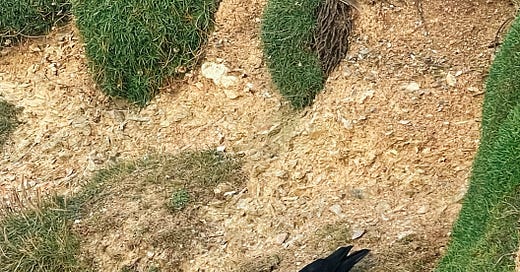The choughs’ ears must be burning as bright red as their legs and beaks.
Around 50 people are gathered in a courtyard chomping pasties and chewing the fat about choughs.
All volunteers and staff from the Cornish Chough Conservation Network’s partner organisations1, they’ve built up an appetite with a short walk and a lesson in the art of chough watching.
If the Community Shield is the traditional curtain raiser to the new football season™, then the network’s spring gathering is the traditional curtain raiser to the chough breeding season.
And just as there are always new signings on show at Wembley, there were plenty of fresh faces at the National Trust’s Pentireglaze complex – many recruited in the close season by me in my voluntary role as a chough conservation officer for the RSPB.
You see, it’s become hard to keep up with Cornwall’s choughs. Twenty-five years ago, there were none. Now there are more than 300. And after 40 successful pairs added another 100 choughlets to the population last year, our team needed strengthening – particularly on the north coast, where the gathering is being held in acknowledgement of it being the big growth area as new pairs seek space to start a family.
For the first time since choughs returned to Cornwall in 20012 and heroes sat on windswept, rain-lashed clifftops 24/7 to protect the precious nests from disturbance and egg collectors, we can now cover the whole coast from the Roseland peninsula in the south all the way round to Bude in the north.
Thankfully, protection is the lesser of the volunteers’ three roles these days3. The focus is finding and monitoring nests. But how do you do that when choughs hide them in disused mineshafts and out-of-the-way crevices in craggy cliffs?
It’s all about watching their behaviour, chough expert Hilary Mitchell, of Cornwall Birds, explained to us on a bright and breezy clifftop at the halfway point of our walk.
A pair flying above your head is no sign of breeding evidence; one bird feeding another4 probably is; and two birds visiting a potential nest site but only one coming out is a definite. Those are just three of the 18 coded behaviours on the checklist.
The volunteers were eager to see a chough, but while we could arrange pasties, a flypast was beyond us.
Their enthusiasm reflects Cornwall’s fondness for its national bird – and who wouldn’t be charmed by the flash of red, the “chee-ow!” and the rollercoaster flight?
Between mouthfuls of pasty, some say the chance to be part of a conservation effort that has had such positive results was behind their decision to join up.
In a world of tragic, demoralising species decline, the fact they are a success story may now be the rarest thing about the Cornish chough.
Basking sharks seen on this walk: 0
Total basking sharks seen to date: 0
RSPB, National Trust, Cornwall Birdwatching and Preservation Society (Cornwall Birds) and Natural England.
All by themselves. People often say they were reintroduced, but that’s one of few things that will prompt me to reply: “Well, AC-TU-ALLY …”
Although as PC Lee Skinner, wildlife crime officer for Devon and Cornwall Police, told the gathering, not only is disturbance still an issue but, believe it or not, egg collecting too.
It’ll be a male feeding a female, but they’re tricky to tell apart.





It's wonderful that the choughs are now doing so well in Cornwall. Years ago i saw some on Anglesey.
I really want to see a chough!